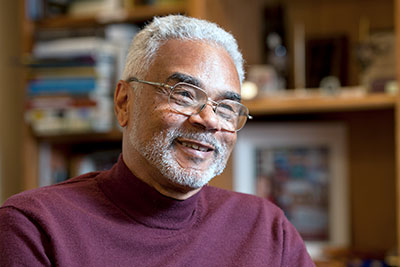Nonviolence Has Potential to Dismantle Racism
Abstract
Experts say that while being a well-adjusted individual is healthy, no one should be adjusted to a racist society, and nonviolence can teach students how to find common ground despite their differences.
During his 1967 speech at the American Psychological Association’s annual meeting, Dr. Martin Luther King Jr. pointed out that being maladjusted is generally considered bad by mental health professionals. Yet there are some societal ideas to which people should never be adjusted—particularly racial discrimination and segregation.
In a session at APA’s online 2021 Annual Meeting, Nassir Ghaemi, M.D., M.P.H., invoked King’s words: “If you’re in a racist society, then adjustment means conforming to racism.”
“As a psychiatrist,” he said, “I’ve always thought that idea is pretty interesting because what [King is] telling us is that in a social sense, normal mental health is bad, and some kind of psychological maladjustment is good.”
Ghaemi, an adjunct professor of psychiatry at Tufts University, was the moderator of the session “The Psychology of Racism and Nonviolence.”

Mental health professionals are in a role to address racism, but they must do so within their own science first, says Steven Roberts, Ph.D.
Psychiatrists and psychologists “are in a very important, powerful position from which to decrease racism in the real world,” said Steven Roberts, Ph.D., an assistant professor of psychology at Stanford University. “But the extent to which we can do that—affect or change racism in the real world—depends on the extent to which we can change and reduce racism within our own science.”
Roberts shared findings from research he has done related to racism within scientific publications. Because the editors of scientific journals are in powerful positions, as they decide what research is worth publishing, Roberts and his colleagues analyzed the demographics of the editors of top-tier cognitive, developmental, and social psychology journals. They published their findings in June 2020 in Perspectives on Psychological Science.
Of about 3,700 articles on cognitive psychology published between 1974 and 2018, the journals in which they appeared were headed by White editors, while 89% of 10,300 articles on developmental psychology and 96% of 8,280 articles on social psychology appeared in journals headed by White editors.
AJP Works to Combat Racism, Enhance Inclusiveness
Over the past year, the American Journal of Psychiatry has prioritized efforts to address diversity, inclusivity, and equity (DEI) within the journal, said Editor-in-Chief Ned Kalin, M.D., in an interview. These efforts have included prioritizing papers that address racism and psychiatric health, posting these papers as soon as they are accepted and highlighting them at the top of the journal’s website, expanding the representativeness of voices guiding editorial policies through editorial board appointments, and holding discussions with the editorial board about how the journal can enhance inclusiveness.
The March 2021 issue featured a piece written by leaders at nine major U.S. academic institutions, “Psychiatry Diversity Leadership in Academic Medicine: Guidelines for Success,” which called for DEI efforts to be given financial, administrative, and structural support to effect structural change. The July issue features several articles on issues related to the severe negative impacts of structural racism, socioeconomic inequities, and the stigmatization of mental health care.
Journals play a hugely important role in raising awareness about the impact that structural racism has on mental health and well-being, Kalin said. “This is an area that has been long overlooked in the field of psychiatry up until recently,” he said. “The deputy editors, editorial board, and I are dedicated to using the journal as best we can to effect change related to structural racism, especially its impact on mental health and well-being.”
Further, Roberts added that “the proportion of papers that focus on race and racism is predicted by the race of the editor, such that, under White editors, 4% of papers focus on race, and under editors of color, it almost triples to 11%.”
“Teaching nonviolence can undermine racism,” said Charles Collyer, Ph.D., professor emeritus in the Department of Psychology at the University of Rhode Island. Racism is learned by individuals, both directly and indirectly, and it is reinforced by the American culture of violence. Roberts’ research, Collyer continued, points to some of the factors that support violence within the American culture: categories, factions, segregation, hierarchies, and others. “The pervasiveness of violence starts to come into focus when we start to consider how many things support and strengthen it,” Collyer said.
People rely on nonviolent decision-making every day, Collyer pointed out. “We depend on it for our survival, but nonviolence is taken for granted,” he said. As a nonviolence educator, he teaches courses that delve into the psychology of violence and nonviolence. “I think of what I do as primary prevention: Trying to inoculate young people against racism, violence, and corruption,” he said.
“Studying nonviolence helps students to see other people as brothers and sisters,” he added. “They see that other people are more similar to themselves than they had thought, and they see that there is more of a possibility of finding common ground, even with people who are very different.”
Ghaemi noted that the concept of nonviolence in American culture is unnatural. “You have to be taught that it's a good thing, but it doesn't come naturally.”
During his presentation, Collyer said that many of his students expressed the desire for nonviolence to be taught in elementary, middle, or high school, so they could learn the concepts before they reached college.
Collyer said he regards violence as a sign that somebody failed. Sometimes, the failure occurs with the person who committed the act of violence, while at other times the failure exists somewhere in society. Roberts gave the example of a Black man getting into an elevator with a White woman, and the pressure the man feels to change his body language so he appears as nonthreatening as possible. “In that case, he’s engaging in deep violence upon himself,” Roberts said. Collyer pointed out that this example of violence toward the self is also a failure, even though it’s not the failure of the man in the scenario.

It is vital to listen to the people who are leading anti-racist movements as they develop ideas that respond to the struggles they experience, says Clayborne Carson, Ph.D., who participated in the civil rights movement.
Nonviolent strategies are often used in struggles against racism. In his presentation, however, Clayborne Carson, Ph.D., urged caution before coming to conclusions about the intent of activists during the civil rights movement. Carson is emeritus professor of history and founder and director of the Martin Luther King Jr. Research and Education Institute at Stanford University. He also participated in the movement himself. “I don’t know whether most of the people who became involved in the sit-ins and freedom rides were drawn there by their commitment to nonviolent struggle,” he said. “I think, to some degree, they were committed to doing whatever would work in the South during that time.”
He emphasized the importance of learning from both the participants and the movements, including the anti-racist movement that is going on now. He said he expects new ideas to arise from the current movement that address problems people are living through now. “People who have taken the lead in the current struggles are dealing with very systematic kinds of oppression that are maintained by force,” he said, noting the systematic oppression of Black communities.
“At the end of his life, King himself wrote the book Where Do We Go From Here?” Carson continued. “I think it’s still an unanswered question. It’s not clear where we’re going.” ■
“Racial Inequality in Psychological Research: Trends of the Past and Recommendations for the Future” is posted here.



